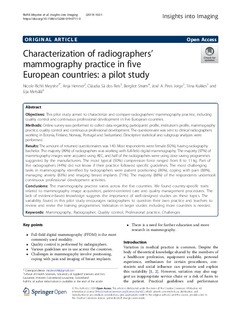| dc.contributor.author | Richli Meystre, Nicole | |
| dc.contributor.author | Henner, Anja | |
| dc.contributor.author | Sà dos Reis, Claudia | |
| dc.contributor.author | Strøm, Bergliot | |
| dc.contributor.author | Pires Jorge, Jose A | |
| dc.contributor.author | Kukkes, Tiina | |
| dc.contributor.author | Metsala, Eija | |
| dc.date.accessioned | 2019-12-18T10:18:28Z | |
| dc.date.available | 2019-12-18T10:18:28Z | |
| dc.date.created | 2019-08-22T14:56:57Z | |
| dc.date.issued | 2019 | |
| dc.identifier.citation | Richli Meystre, N., Henner, A., Sà dos Reis, C., Strøm, B., Pires Jorge, J. A., Kukkes, T., & Metsälä, E. (2019). Characterization of radiographers’ mammography practice in five European countries: a pilot study. Insights into Imaging, 10(1). | nb_NO |
| dc.identifier.issn | 1869-4101 | |
| dc.identifier.uri | http://hdl.handle.net/11250/2633871 | |
| dc.description.abstract | Objectives
This pilot study aimed to characterize and compare radiographers’ mammography practice, including quality control and continuous professional development in five European countries.
Methods
Online survey was performed to collect data regarding participants’ profile, institution’s profile, mammography practice, quality control and continuous professional development. The questionnaire was sent to clinical radiographers working in Estonia, Finland, Norway, Portugal and Switzerland. Descriptive statistical and subgroup analyzes were performed.
Results
The amount of returned questionnaires was 140. Most respondents were female (92%), having radiography bachelor. The majority (89%) of radiographers was working with full-field digital mammography. The majority (97%) of mammography images were acquired using AEC, and half of the radiographers were using dose saving programmes suggested by the manufacturers. The most typical (50%) compression force ranged from 8 to 11 kg. Part of the radiographers (44%) did not know if their practice followed specific guidelines. The most challenging tasks in mammography identified by radiographers were patient positioning (86%), coping with pain (88%), managing anxiety (83%) and imaging breast implants (71%). The majority (88%) of the respondents undertook continuous professional development activities.
Conclusions
The mammography practice varies across the five countries. We found country-specific traits related to mammography image acquisition, patient-centered care and quality management procedures. The lack of evidence-based knowledge suggests the importance of well-designed studies on these topics. The variability found in this pilot study encourages radiographers to question their own practice and teachers to review and revise the training programmes. Validation in larger studies including more countries is needed. | nb_NO |
| dc.language.iso | eng | nb_NO |
| dc.publisher | Springer | nb_NO |
| dc.rights | Navngivelse 4.0 Internasjonal | * |
| dc.rights.uri | http://creativecommons.org/licenses/by/4.0/deed.no | * |
| dc.subject | mammography | nb_NO |
| dc.subject | radiographer | nb_NO |
| dc.subject | quality control | nb_NO |
| dc.subject | professional practice | nb_NO |
| dc.subject | challenges | nb_NO |
| dc.title | Characterization of radiographers’ mammography practice in five European countries: a pilot study | nb_NO |
| dc.type | Journal article | nb_NO |
| dc.type | Peer reviewed | nb_NO |
| dc.description.version | publishedVersion | nb_NO |
| dc.rights.holder | © The Author(s) 2019 | nb_NO |
| dc.subject.nsi | VDP::Medisinske Fag: 700::Klinisk medisinske fag: 750::Radiologi og bildediagnostikk: 763 | nb_NO |
| dc.source.pagenumber | 1-11 | nb_NO |
| dc.source.volume | 10 | nb_NO |
| dc.source.journal | Insight into Imaging | nb_NO |
| dc.source.issue | 1 | nb_NO |
| dc.identifier.doi | 10.1186/s13244-019-0711-0 | |
| dc.identifier.cristin | 1718086 | |
| cristin.unitcode | 203,11,2,0 | |
| cristin.unitname | Institutt for helse og funksjon | |
| cristin.ispublished | true | |
| cristin.fulltext | original | |
| cristin.qualitycode | 1 | |

